
April 2019 - RAM Laramie and Airstream Smartweigh
There are certain times in Airstream life when you wonder how safe your rig is, maybe a fleeting moment as you load up your gear for the next four month road trip or when you are speeding down the interstate with the herd and realize that you are going faster than reason or necessity dictates. Some reassurance can be obtained from knowing your rig is well within the manufacturer’s weight and loading safety specifications and ratings and your load is correctly distributed.Several issues are of concern when overloading your rig. Basically, asking your tow vehicle or trailer to do more work than they were designed to do and the cost of added wear and tear to your valuable assets. Add the safety risk and inconvenience of equipment failure such as tire blow-outs to the potential hazard mix, then consider the legal issues of exceeding legal weight limit laws, and the contributory cause to any accident verdict if an overweight vehicle is involved.
We belong to a RV group called Escapees Club, sometimes known as SKP, who support full-time RV’ers with a wide range of services including mail forwarding, education, resident and domicile status, job search, and technical assistance including rig weighing. Escapees have three locations: Livingstone TX, Congress AZ and Bushnell FL. We called a month ahead to make an appointment and reserve a site for the night before weighing.
We checked in with Sumter Oaks RV in Florida in February 2018 and again February 2019. The initial visit provides the baseline data and gives you reassurance and confidence in the rig setup.
Between these two dates we made significant modifications to our Airstream Flying Cloud 25 RB such as adding cabinetry and installing a new energy system including solar panels, a heavy-duty inverter and two GPL-6 golf cart batteries. Between weighings, we also adjusted hitch height to level the trailer when hitched up and adjusted the Equalizer bars to transfer more load to the towing vehicle.
The initial contact with John Hamilton, our SKP weighmaster suggests the completion of the SmartWeigh info sheet with tow vehicle and trailer ratings (GAWR, GVWR & GCWR - more on this later) and installed tire info.) The actual weighing procedure takes less than an hour on the specially designed weighing station and costs $55 for our configuration. (Download link to our info sheet provided below). First the towing vehicle is weighed without trailer. The front wheels are positioned on the two recessed scales, and then you roll forward to weigh the two rear wheels. Your normal passenger and load configuration is recommended in order to provide realistic day-to-day operating conditions.
With regard to establishing normal operating conditions, it’s advisable to record tank levels at the time of weighing. When full truck fuel, fresh water, gray tank and black tank levels, not forgetting the two propane tanks on the tongue, account for 1,200 lbs of consumables, and this may have a significant impact on the recommendations later in this process.
Next you return to the weighing platform fully hitched up with weight distribution system in place. Four pairs of weight readings are taken as you move incrementally over the scales. That completes the data gathering stage, and a helpful measuring of rig height is noted on the info sheet.
Finally, in the calculation phase, we transfer data to an Excel spreadsheet (also available to download). The blue cells show weight data gathered at the scales. The first calculation using hitched and unhitched tow vehicle axle weights determines tongue weight. In our case, a tongue weight of 950 lbs represents 16% of the trailer weight, which is within the recommended range (Line C).
The second calculation checks axle loads compared to truck and trailer manufacturer ratings, GAWR, which are posted on each vehicle. On the spreadsheet our RAM truck under tow operates at 76% to 79% of manufacturers rating (Line F) and the Airstream operates at 71% and 86% of the builder’s rating (Line N). Note the reasonable difference of 150 lbs between right and left sides of the trailer, and the significant difference of 550 lbs between the front and rear trailer axles. The heavier rear axle suggests a change in the hitch height and a possible internal redistribution of trailer content.
The third calculation checks Gross Vehicle Weight Rating, GVWR, for truck and trailer. The RAM under tow has a small margin of 300 lbs and operates at 97% of max rating (Line E). This is pretty close to max and no further truck cargo should be considered especially after refueling! The Airstream GVWR has a margin of 400 lbs and is running at 95% of maximum rating (Line J).
The fourth and last calculation addresses Gross Combined Weight Rating, GCWR, as specified by Dodge for our RAM Cummings 2500 Laramie. Combined weight of both truck and trailer comes in at a comfortable 15,650 lbs or 62% of max rating (Line Q).
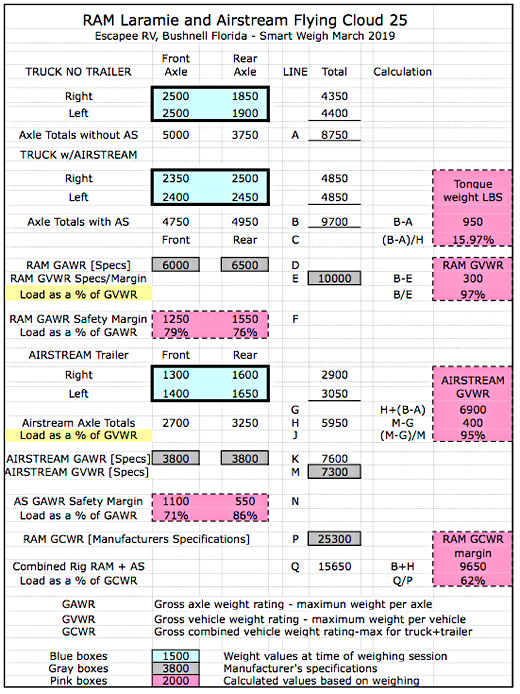
So what does all this mean and how do we use this information? Hopefully in your situation there are no red flags. However, even in the best of cases there is a limit to the load you can carry and the SmartWeigh process shows you where the tolerances are. Loading up the back of the truck with unnecessary gear can easily take you over the axle rating limit, especially with a full tank of fuel. In our situation the tank was 1/4 full or 8 gallons. A full diesel tank at 32 gallons weighs 225 lbs, so that adds 175 lbs and takes our rear axle GAWR loading from 76% to 80% but more importantly this takes our GVWR from 97% to 99%. Each 100 lbs of cargo adds 1% to the load, so just taking two extra camping passengers along pushes you over the top. Maybe Santa”s list has me down for a one ton RAM! Remember when unhitched we do have the 950 lbs of tongue weight now available to play with.
Similarly the Airstream W/G/B tanks were at 10%, 10% and 25% respectively - 140 lbs water weight cumulative. Take those three tanks’ capacities to 100% and we add 780 lbs largely over the rear axle and our GVWR has shifted from 95% to 105%. This is an excellent reason to empty gray and black tanks before traveling and keep a modest 20% fresh water for basic necessities en route! Even more comforting is the fact that this avoids the tail weight wagging the dog!
An additional useful check is comparing your truck and trailer tire load ratings against the blue box recorded weights. Our RAM Michelin LTX 275/70R18 tires are rated at 3,640 lbs, and we carry a max load of 2,500 lbs. The Airstream Michelin LTX 225/75R16 are rated at 2,680 lbs, and we carry a max of 1,600 lbs per tire. Both vehicles are well within the comfort zone. About a year ago we upgraded our 15” Goodyear Marathons to 16” Michelin Defenders to give us a better margin of safety, reliability, and performance.
To summarize our SmartWeigh results, we are well within GAWR, GCWR , and tire load rating. The area of concern is the GVWR on both the truck at 97% and on the Airstream at 95%. Both of these load factors are too close for comfort and require a brutal assessment and shedding of excess weight – an Airstream version of WeightWatchers!
One of our self-imposed routines is to completely empty our Airstream and truck on the return home from our extended trips. Back to square one! It helps us dispose of the unnecessary or underused gear in favor of liberating space for something new! It’s a pain, but it can be quite rewarding to enjoy a no clutter lifestyle and keep control of trailer weight.
Traveling with the assured knowledge that our vehicles are not overloaded and well balanced gives us one less thing to worry about! Losing weight in both tow vehicle and towed trailer will give you better gas mileage, longer tire life, and shorter stopping distances. At least one has done the best one can to avoid becoming one of those road statistics! Safe travels and see you down the road!
Rig preliminary information sheet:
http://www.db26.net/airstream/links/skp-smartweight-2019.pdf
Excel calculation spreadsheet:
http://www.db26.net/airstream/links/skp-smartweight-2019.xlsx
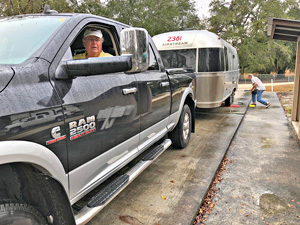
Weighing each axle of truck and trailer requires the rig to pull forward for the eight – two per axle – scale measurements to be recorded.
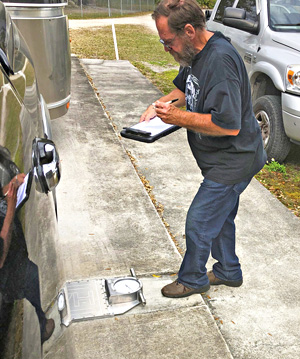
John Hamilton, Escapee weighmaster, records each scale reading on to the data sheet for the rig.
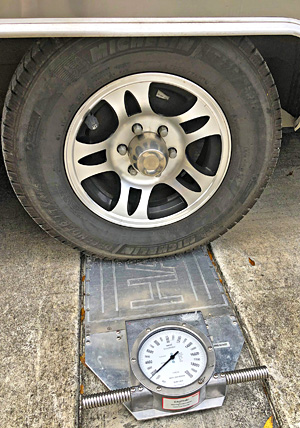
A pair of scales are used, one on each side of the rig. These highly accurate devices are recessed level into the concrete weighing platform so that no variations are introduced in the weighing process.
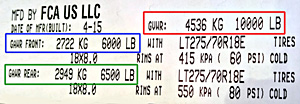
Data from the door sticker on the RAM is transferred to the data sheet and to the spreadsheet – Line D & E.
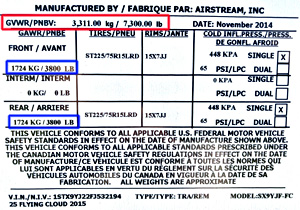
Data from the Airstream data plate is transferred to the data sheet and to the spreadsheet – Line K & M.
 Margaret & David Broad (WBCCI #2381) from Tappahannock Virginia, traveling 8 months of the year since July 2016 in their 2015 Flying Cloud 25 RB. We recently journeyed on the 2019 Cajun Country Caravan along with Airstreaming friends John & Victoria Magnacca (left) travelers with us on the 2016 South West Adventure and 2018 Alaska caravans. You can email questions or comments to airstream@db26.net Their travel blog is at www.flyingcloud25.blogspot.com and David also publishes an Airstream improvement page at www.facebook.com/airstreamtweaks |